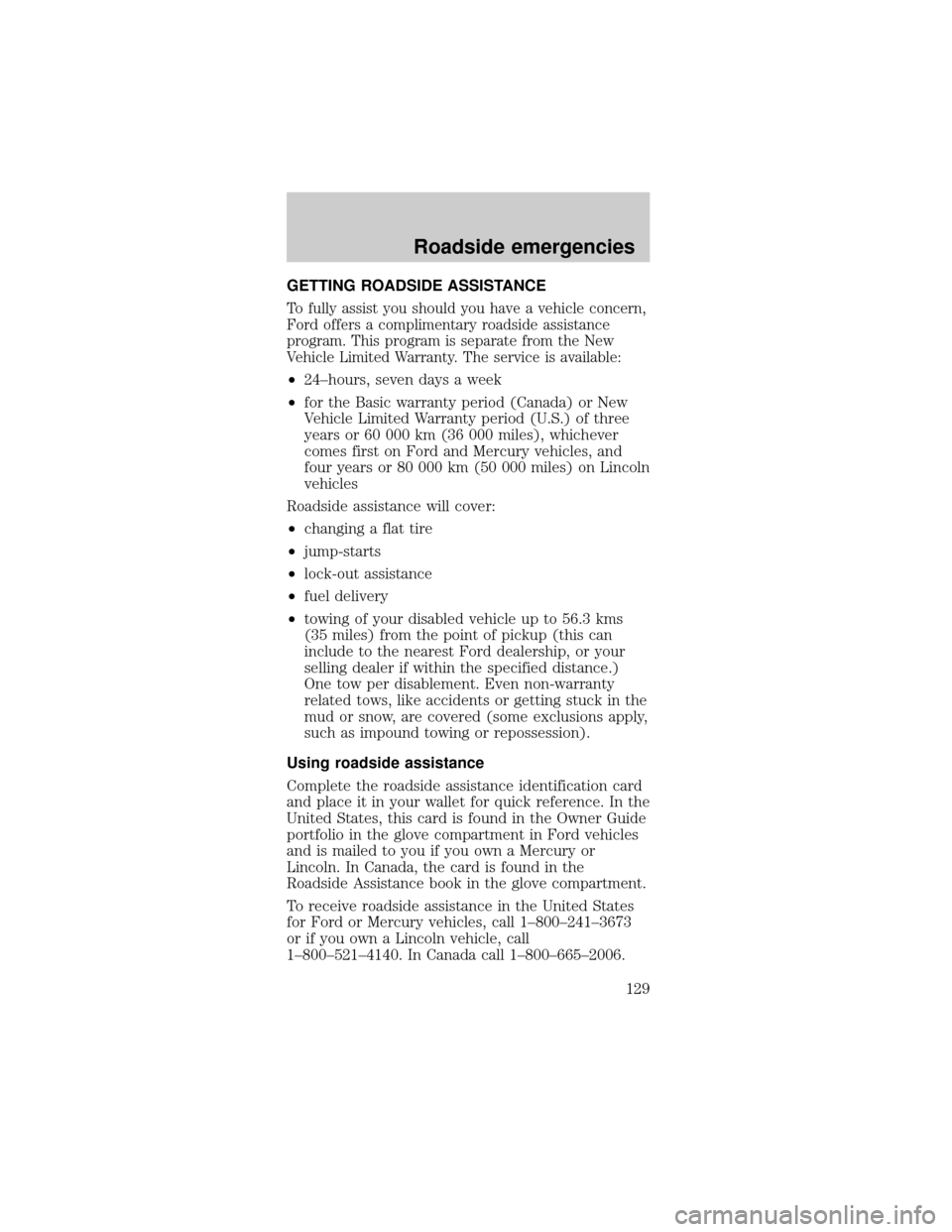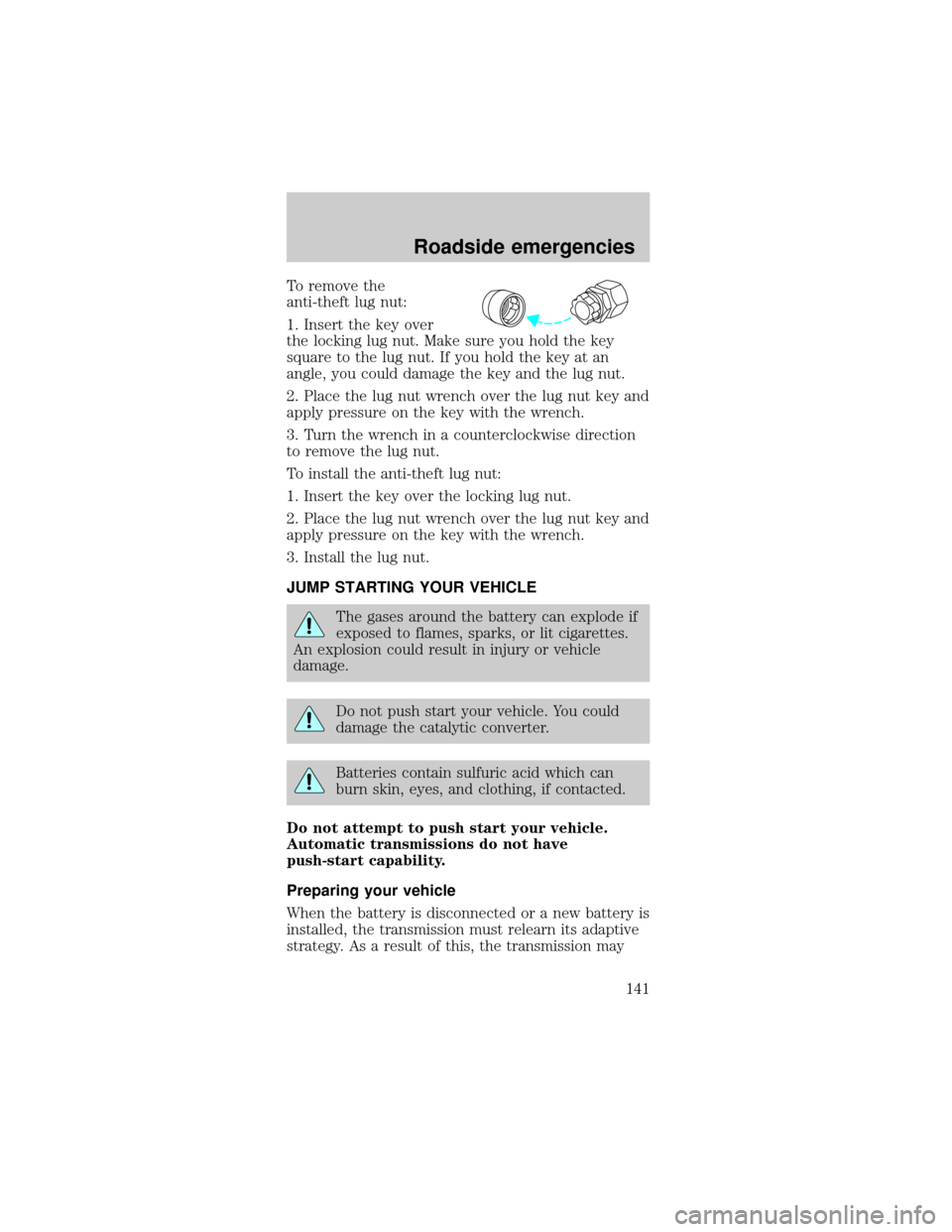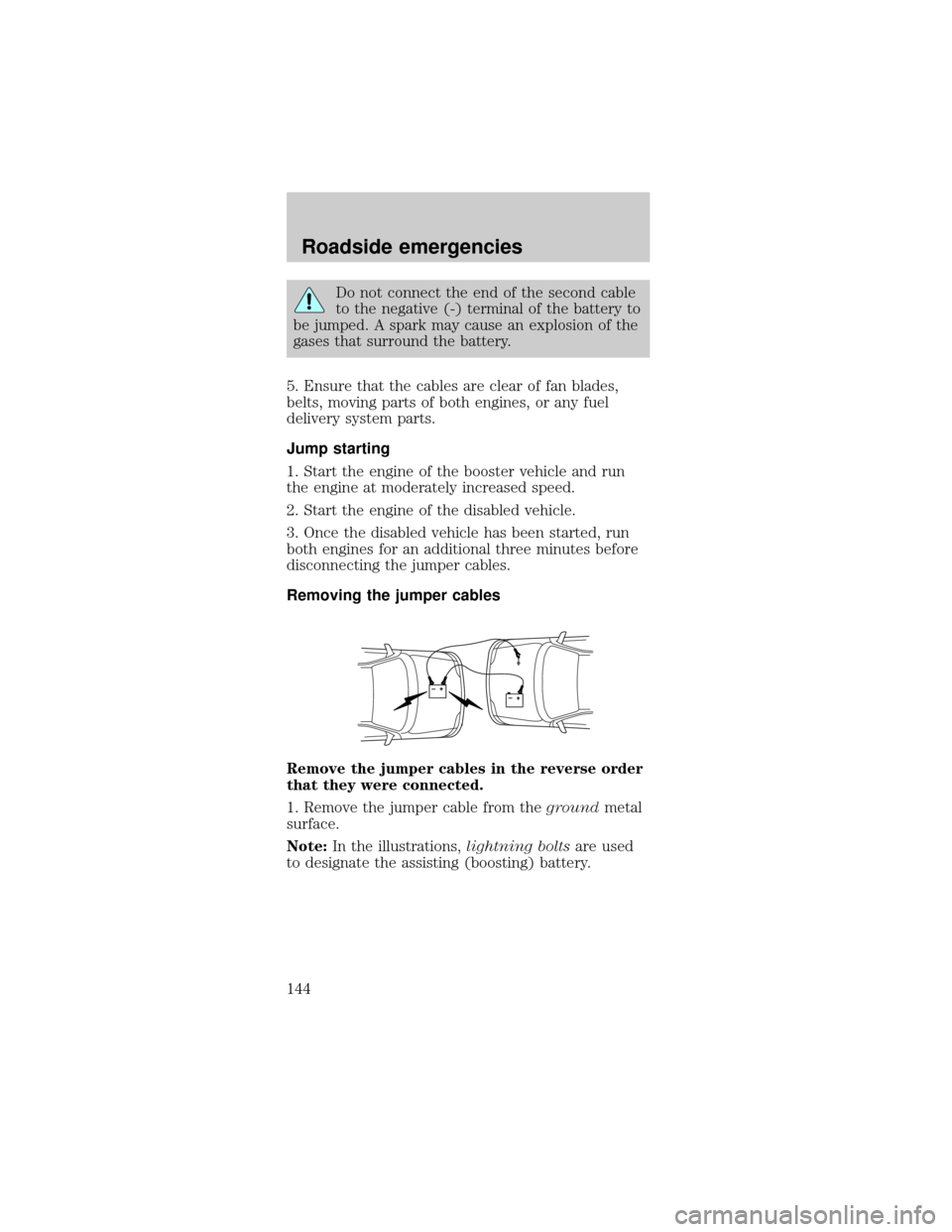2001 FORD MUSTANG jump start
[x] Cancel search: jump startPage 129 of 240

GETTING ROADSIDE ASSISTANCE
To fully assist you should you have a vehicle concern,
Ford offers a complimentary roadside assistance
program. This program is separate from the New
Vehicle Limited Warranty. The service is available:
²24±hours, seven days a week
²for the Basic warranty period (Canada) or New
Vehicle Limited Warranty period (U.S.) of three
years or 60 000 km (36 000 miles), whichever
comes first on Ford and Mercury vehicles, and
four years or 80 000 km (50 000 miles) on Lincoln
vehicles
Roadside assistance will cover:
²changing a flat tire
²jump-starts
²lock-out assistance
²fuel delivery
²towing of your disabled vehicle up to 56.3 kms
(35 miles) from the point of pickup (this can
include to the nearest Ford dealership, or your
selling dealer if within the specified distance.)
One tow per disablement. Even non-warranty
related tows, like accidents or getting stuck in the
mud or snow, are covered (some exclusions apply,
such as impound towing or repossession).
Using roadside assistance
Complete the roadside assistance identification card
and place it in your wallet for quick reference. In the
United States, this card is found in the Owner Guide
portfolio in the glove compartment in Ford vehicles
and is mailed to you if you own a Mercury or
Lincoln. In Canada, the card is found in the
Roadside Assistance book in the glove compartment.
To receive roadside assistance in the United States
for Ford or Mercury vehicles, call 1±800±241±3673
or if you own a Lincoln vehicle, call
1±800±521±4140. In Canada call 1±800±665±2006.
Roadside emergencies
129
Page 141 of 240

To remove the
anti-theft lug nut:
1. Insert the key over
the locking lug nut. Make sure you hold the key
square to the lug nut. If you hold the key at an
angle, you could damage the key and the lug nut.
2. Place the lug nut wrench over the lug nut key and
apply pressure on the key with the wrench.
3. Turn the wrench in a counterclockwise direction
to remove the lug nut.
To install the anti-theft lug nut:
1. Insert the key over the locking lug nut.
2. Place the lug nut wrench over the lug nut key and
apply pressure on the key with the wrench.
3. Install the lug nut.
JUMP STARTING YOUR VEHICLE
The gases around the battery can explode if
exposed to flames, sparks, or lit cigarettes.
An explosion could result in injury or vehicle
damage.
Do not push start your vehicle. You could
damage the catalytic converter.
Batteries contain sulfuric acid which can
burn skin, eyes, and clothing, if contacted.
Do not attempt to push start your vehicle.
Automatic transmissions do not have
push-start capability.
Preparing your vehicle
When the battery is disconnected or a new battery is
installed, the transmission must relearn its adaptive
strategy. As a result of this, the transmission may
Roadside emergencies
141
Page 142 of 240

shift firmly. This operation is considered normal and
will not effect function or durability of the
transmission. Over time, the adaptive learning
process will fully update transmission operation to
its optimum shift feel.
1.Use only a 12±volt supply to start your
vehicle.
2. Do not disconnect the battery of the disabled
vehicle as this could damage the vehicle's electrical
system.
3. Park the booster vehicle close to the hood of the
disabled vehicle making sure the two vehiclesdo
nottouch. Set the parking brake on both vehicles
and stay clear of the engine cooling fan and other
moving parts.
4. Check all battery terminals and remove any
excessive corrosion before you attach the battery
cables.
5. Turn the heater fan on in both vehicles to protect
any electrical surges. Turn all other accessories off.
Connecting the jumper cables
1. Connect the positive (+) booster cable to the
positive (+) terminal of the discharged battery.
Note:In the illustrations,lightning boltsare used
to designate the assisting (boosting) battery.
+–+–
Roadside emergencies
142
Page 144 of 240

Do not connect the end of the second cable
to the negative (-) terminal of the battery to
be jumped. A spark may cause an explosion of the
gases that surround the battery.
5. Ensure that the cables are clear of fan blades,
belts, moving parts of both engines, or any fuel
delivery system parts.
Jump starting
1. Start the engine of the booster vehicle and run
the engine at moderately increased speed.
2. Start the engine of the disabled vehicle.
3. Once the disabled vehicle has been started, run
both engines for an additional three minutes before
disconnecting the jumper cables.
Removing the jumper cables
Remove the jumper cables in the reverse order
that they were connected.
1. Remove the jumper cable from thegroundmetal
surface.
Note:In the illustrations,lightning boltsare used
to designate the assisting (boosting) battery.
+–+–
Roadside emergencies
144
Page 145 of 240

2. Remove the jumper cable on the negative (-)
connection of the booster vehicle's battery.
3. Remove the jumper cable from the positive (+)
terminal of the booster vehicle's battery.
4. Remove the jumper cable from the positive (+)
terminal of the disabled vehicle's battery.
After the disabled vehicle has been started and the
jumper cables removed, allow it to idle for several
minutes so the engine computer canrelearnits idle
conditions.
When the battery is disconnected or a new battery is
installed, the transmission must relearn its adaptive
strategy. As a result of this, the transmission may
shift firmly. This operation is considered normal and
+–+–
+–+–
+–+–
Roadside emergencies
145
Page 230 of 240

The Dispute
Settlement
Board ..................... 216
Utilizing the
Mediation/Arbitration
Program ................. 219
D
Daytime running lamps
(see Lamps) .............. 18
Defrost
rear window ............ 19
Dipstick
automatic transmission
fluid ........................ 167
engine oil ............... 151
Doors
lubricant
specifications ........ 208
Driving under special
conditions
through water ....... 128
E
Emergencies, roadside
jump-starting ........ 141
Emission control
system ...................... 190
Engine .............. 209±210
check engine/service
engine soon light ...... 9
cleaning ................. 202
coolant ................... 157
idle speed
control ................... 171
lubrication
specifications. 208±209refill capacities ...... 206
service
points ............. 150±151
starting after a
collision ................. 130
Engine block
heater ....................... 106
Engine oil ................ 151
checking and
adding .................... 151
dipstick .................. 151
filter,
specifications. 154, 206
recommendations.. 154
refill capacities ...... 206
specifications. 208±209
Exhaust fumes ........ 107
F
Floor mats ................. 60
Fluid capacities ....... 206
Foglamps ................... 19
Fuel .......................... 180
calculating fuel
economy ................ 186
cap ................... 11, 182
capacity ................. 206
choosing the
right fuel ................ 183
comparisons with EPA
fuel economy
estimates ............... 190
detergent in fuel ... 185
filling your vehicle
with
fuel ......... 180, 182, 186
filter,
specifications. 185, 206
Index
230
Page 232 of 240

Instrument panel
cleaning ................. 204
cluster ................ 8, 204
lighting up panel and
interior ..................... 19
location of
components ............... 8
J
Jack .......................... 137
positioning ............. 137
storage ................... 137
Jump-starting your
vehicle ...................... 141
K
Keys ..................... 67±69
key in ignition
chime ....................... 13
positions of the
ignition .................... 52
removing from the
ignition .................. 122
L
Lamps
bulb replacement
specifications
chart ...................... 197
cargo lamps ............. 19
daytime running
light .......................... 18
fog lamps ................. 19
headlamps ....... 18, 193
headlamps, flash to
pass .......................... 51
instrument panel,
dimming ................... 19interior
lamps ............... 56, 197
replacing
bulbs .............. 192±196
Lane change indicator
(see Turn signal) ...... 51
Lights, warning and
indicator ...................... 8
air bag ........................ 9
anti-lock brakes
(ABS) .............. 12, 109
anti-theft ................... 9
brake ........................ 13
charging system ........ 9
fuel cap light ........... 11
high beam ................. 8
low fuel .................... 11
overdrive off ............ 12
safety belt ................. 9
service engine soon .. 9
traction control
active ....................... 12
turn signal
indicator .................... 8
Load limits ............... 122
GAWR .................... 122
GVWR .................... 122
trailer towing ........ 122
Locks
doors ........................ 57
Lubricant
specifications ... 208±209
Lug nuts,
anti-theft .................. 140
Lumbar support,
seats ........................... 75
Index
232
Page 234 of 240

Safety seats for
children ...................... 95
Seat belts (see Safety
restraints) .................. 76
Seats .......................... 73
child safety seats .... 95
cleaning ......... 204±205
easy access/easyout
feature ..................... 75
SecuriLock passive
anti-theft
system .................. 67±69
Servicing your
vehicle ...................... 147
Spark plugs,
specifications ........... 206
, 209±210
Special notice .............. 3
Specification chart,
lubricants ......... 208±209
Speed control ............ 53
Speedometer ............. 15
Starting your
vehicle ...... 103±104, 106
jump starting ........ 141
Steering wheel
tilting ....................... 52
T
Tachometer ............... 16
Tires ......... 137, 175±177
changing ........ 137±138
checking the
pressure ................. 177
replacing ................ 178
rotating .................. 177snow tires and
chains .................... 179
tire grades ............. 176
treadwear .............. 175
Towing ..................... 124
recreational
towing .................... 127
trailer towing ........ 124
wrecker .................. 146
Traction
control ............... 50, 111
active light .............. 12
Traction-lok rear
axle .......................... 122
Transmission
automation
operation ............... 113
fluid, checking and
adding
(automatic) ........... 167
fluid, checking and
adding (manual) ... 170
fluid, refill
capacities ............... 206
lubricant
specifications. 208±209
manual operation .. 119
Trip odometer ........... 17
Trunk ......................... 71
remote release .. 50, 65
Turn signal ............ 8, 51
V
Vehicle
dimensions ............... 210
Vehicle Identification
Number (VIN) ......... 211
Index
234